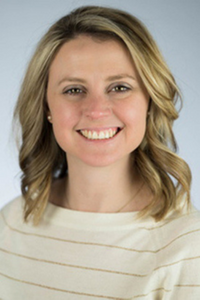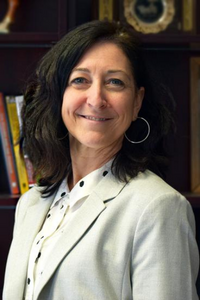The sky’s the limit
Expanding role of university-industry partnerships increases opportunities for student development, research, and more

Expanding role of university-industry partnerships increases opportunities for student development, research, and more
Degree in hand, veterinary college graduates embark on widely different career paths. While some graduates enter private practice, others secure positions in academia where they serve as educators and researchers.
Graduates of the University of Minnesota College of Veterinary Medicine’s (CVM) DVM and graduate programs work internationally to prevent emerging zoonotic diseases or locally with agriculturally-focused industry partners. Research-driven grads may become pathologists in public diagnostic labs or join a medical device company to apply knowledge gained in naturally-occurring animal models to human disease.
As the list of plausible employers of vet school graduates grows, so does the list of potential partners for veterinary colleges—partners to help deliver, fund, and translate the College’s research, education, and outreach. When universities engage industry or private partners who depend on them for quality graduates, both groups stand to benefit, and these gains spill over to students and graduates.
Dr. Erin Burton, senior associate dean of academic and student affairs at CVM, is among those who have experienced the upsides of such partnerships. Upon completion of her master’s degree at the University of Missouri, Burton received funding from Boehringer Ingelheim Animal Health as a resident scholar to pursue an infectious disease research project. Boehringer Ingelheim is a pharmaceutical company with a large animal health division focused on vaccines, parasiticides, and therapeutics as well as diagnostics and monitoring platforms.

As a key component of the resident scholar curriculum, Boehringer Ingelheim incorporated leadership training at group headquarters. The program developed skills needed to become a leader in academia or industry—how to write a white paper, prepare effective slide decks for a continuing education talk, or deliver an engaging presentation that stays on target.
Industry is thinking of really interesting ways to be a part of the next generation of veterinarians. Seeing partnership as a way forward, Burton explains, “It behooves Universities to think outside the box with industry and to challenge them to think about what they want the next generation of veterinarians to look like and how, together, we can create the next generation.”
The professional competencies gained through leadership training serve Burton to this day as she shapes future leaders in the field. Boehringer Ingelheim recognized the benefit a partnership offers to the industry as well as when their trainees enter academia with leadership skills—demonstrating those leadership skills to the pipeline of future veterinarians and researchers.
Burton’s experience is one that is becoming more common. University-industry (UI) or public-private partnerships (PPP) are playing an increasingly important role in the University research, education, and outreach mission. The Chronicle of Higher Education recently reported that 71 percent of university leaders surveyed noted an increase in public-private partnerships on campus.
While funding of campus infrastructure and research initiatives by industry partners is easily captured as a line item in university budgets, the nature of the recent uptick in UI partnerships is more nuanced and worth spotlighting.
For colleges of veterinary medicine, in particular, changing demands of the profession drive changes in how they educate and train students in classrooms and labs. As the interplay of human and animal medicine expands, graduates from veterinary colleges enter the workforce with progressively complex knowledge and skill sets—bringing expertise in food safety, animal welfare, genomics, infectious disease control, and environmental and public health—to name but a few.
Equipping veterinary college graduates with such wide-ranging proficiencies increases the cost to deliver and obtain a DVM or PhD. The average veterinary college grad carries debt well into six figures and veterinary colleges struggle to balance budgets and accomplish their missions when asked to do more with fewer resources.
To this end, industry partners also can contribute in ways less obviously connected to their own industry agenda.

For example, Boehringer Ingelheim has offered support to CVM’s student wellness initiative. Working with CVM’s Director of Student Well-Being and Success Dr. Vesna Hampel-Kozar, Boehringer Ingelheim develops programming and funds speakers for the RU Okay Series. The highly targeted series moves beyond yoga or meditation to deliver topics that intersect with professional identity and wellness.
With topics like impression management, psychological safety, and ways to support safety in a team environment, the series gives students the opportunity to hear from speakers who work in the profession— bringing personal experience and context to the well-being concerns of the veterinary community.
“Anytime there's an opportunity to talk openly about the things that both challenge and can help increase wellbeing, “ Hampel-Kozar explains, “it helps reduce stigma and isolation, and normalizes struggles and help-seeking.”
Boehringer Ingelheim's commitment of resources for the series shows support for students’ well-being and mental health.
Student participants appreciate Boehringer Ingelheim’s support of this critical initiative that prepares them to prioritize their own wellness as they enter a profession known to experience psychological stress at significantly higher rates than the general population.
Boehringer Ingelheim and other industry stakeholders are highly motivated to partner with universities and think outside the box to solve the challenges and problems facing universities.
Dr. Jody Ray, director of veterinary school alliances at Boehringer Ingelheim, was a faculty member for several years at a veterinary college prior to crossing over to the industry. His academic experience makes his role as a Boehringer Ingelheim representative in its partnership with CVM that much more valuable when bringing industry resources to bear.
For instance, Ray understands the critical shortage of veterinary technicians facing the profession—two to three vet techs are needed to support a single veterinarian working in the field—but not enough programs to produce grads. With both groups in need of veterinary technologists, they are motivated to work together to pool resources and find solutions.
“Having served in both academia and industry,” Ray explains, “I have seen where the collaborative magic happens. As we are able to combine the strengths of academia with the strengths of industry, we are able to discover better solutions to animal health issues. Boehringer Ingelheim is proud to offer TraxVet—the evolution of the Resident Scholar Program—to help interns, residents, and early career faculty with their developmental and leadership growth.”
When university-industry partners work together in support of overlapping objectives, the sky's the limit. Whether using state-of-the-art industry technology to partner in the delivery of a curriculum module in an active learning classroom or working together to advance diversity, equity, and inclusivity in meaningful ways that enrich academia and industry, UI partnerships are critical to accomplishing CVM’s research, education, and outreach mission.
When missions align, University and industry stakeholders are highly motivated to collaborate in new and exciting ways.